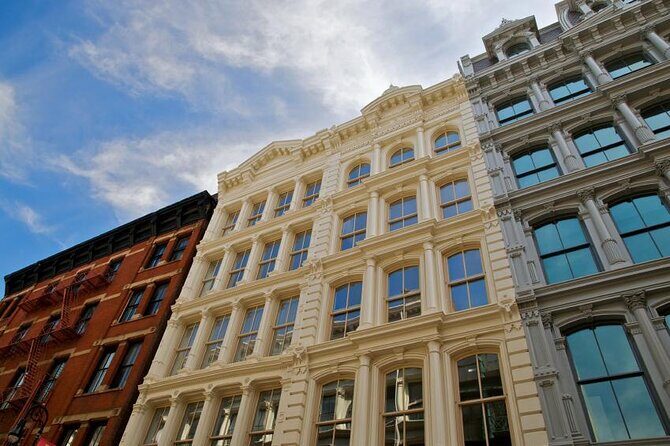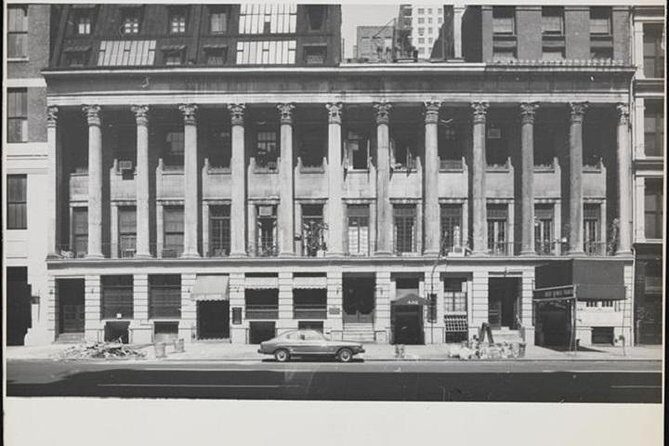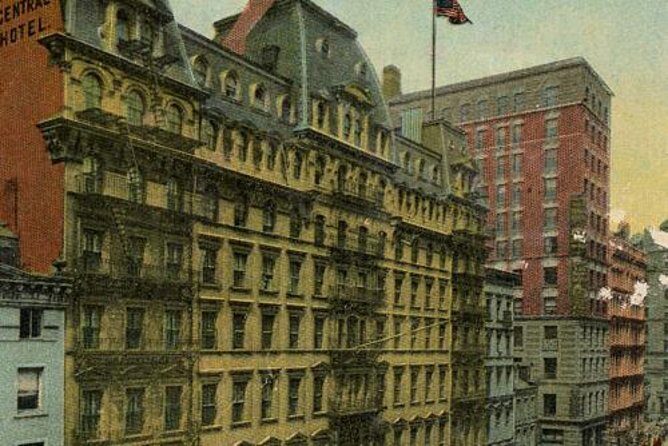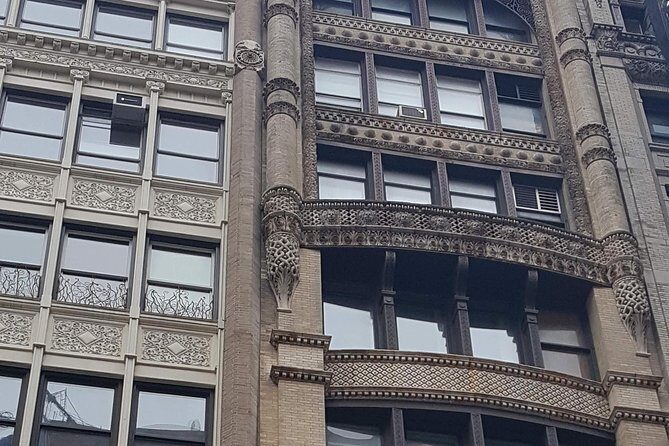Discover the Hidden Stories of 1840s New York on a Guided Walking Tour
This walking tour offers a deep dive into Lower Manhattan’s streets, taking you back to the 1830s and 1840s—an era when New York was transforming from a colonial town into a burgeoning metropolis. Led by a passionate guide, you’ll visit historic sites such as Colonnade Row, the Bayard Condict Building, and the notorious Five Points neighborhood. Priced at $59 per person, the tour lasts about 2 to 3 hours and is designed for those eager to see the city through a different lens—beyond the usual tourist spots.
What we love most about this tour is the way it uncovers architectural details most visitors miss and the rich stories behind the buildings and neighborhoods. The guide’s knowledge brings history to life—no boring plaques or dry facts here, just lively storytelling. We also appreciate how the tour provides a window into social change, illustrating how the city’s geography and architecture reflect its evolving identity.
A potential consideration is that the tour emphasizes architecture and urban history, so if you’re seeking a focus on crime legends or pop culture, this might not be your best fit. Also, since the group is limited to 7 travelers, you’ll enjoy an intimate experience—but it’s wise to book in advance, especially since bookings are typically made about two weeks ahead.
This tour is ideal for history buffs, architecture lovers, and those wanting a more authentic experience of old New York—perfect for travelers who want stories you can’t find in guidebooks and a sense of how the city’s past influences its present.
Key Points

- In-Depth Historical Context: Learn about New York’s social and architectural evolution from the 1830s onward.
- Expert Guiding: Guides are praised for their knowledge, passion, and storytelling ability.
- Architectural Focus: Spot and understand buildings like Louis Sullivan’s only NYC work, and see how architecture shaped the city.
- Authentic Neighborhoods: Walk through NoHo, SoHo, and the Civic Center, seeing how these areas changed over time.
- Less Crowded Experience: Small groups mean more personal attention and stories tailored to your interests.
- Affordable Price for Value: At $59, the tour offers a thorough, engaging look at a crucial period in New York’s history.
A Detailed Look at the Tour Experience

If you're drawn to exploring New York City on foot, we've looked into these other walking experiences
Starting Point: The Public Theater and Colonnade Row
The tour begins at the Public Theater on Lafayette Street, a lively cultural hub. The first stop is the ruins of Colonnade Row, dating from the early 1830s. Here, your guide will explain how this area was once the pinnacle of residential elegance, home to New York’s elite—including members of the Roosevelt and Delano families. You’ll learn that this high ground was once a pleasure garden, a far cry from the busy streets of today. The site’s elevation and its original purpose as a luxurious enclave set the tone for understanding how neighborhoods evolved as the city expanded.
NoHo and the Streetscape
From there, your walk down Broadway is like flipping through a history book. The guide will help you decode the architecture—focusing on building styles, sizes, and modifications that tell stories of economic shifts and social redefinition. The conversation might include insights like how buildings were re-used over decades, reflecting changing needs and tastes. One reviewer highlighted how this part of the tour reveals “fascinating architecture not noticed until pointed out,” emphasizing how much detail often goes unnoticed without expert eyes.
The Bayard Condict Building and Skyscraper Evolution
Next, you’ll stop at the Bayard Condict Building, Louis Sullivan’s only work in New York City. Sullivan, a pioneer of early skyscraper design, contributed significantly to the modern architectural movement. Here, you’ll see how its artistic detailing and structural innovation foreshadowed the skyscrapers that define NYC today. The guide will explain its role in the evolution of city skylines, making it not just a pretty facade but a piece of architectural history.
The Geographic and Social Roots of Downtown
Moving to Houston Street and Broadway, you’ll notice how the grid layout begins—an early sign of city planning. The area’s history as an upper-class residential neighborhood and the site of St. Thomas Episcopal Church provides a backdrop for understanding the city’s initial social divides. This spot marks the starting point of the grid system, a planning decision that shaped the city’s expansion.
Exploring SoHo and the Streets
The tour continues through SoHo, though the name itself only dates to the 1950s. Your guide will explain what locals called this area before “SoHo,” often emphasizing its past as a busy trading and artisan district. The history of Broadway’s transformation is brought to life with stories, images, and descriptions that help you visualize the street’s evolution from a fashionable shopping district to an artists’ haven.
The Social and Retail History at Canal Street
Walking down to Canal Street, you’ll encounter stories of social change and retail development. This stretch was once buzzing with colorful characters and bustling markets—an essential part of Old New York. Your guide might share anecdotes about the people who shopped and worked here, giving color to what might otherwise seem like just another busy street.
Foley Square and the African Burial Ground
At Foley Square, the history turns darker. Today’s Civic Center was once a lake, part of the British colonial shoreline, and nearby was the African Burial Ground—a somber reminder of the city’s enslaved past. The guide will recount how this area was transformed from natural landscape to civic hub, and why it’s important to remember these roots.
The Five Points and the End of the Tour
Finally, the tour culminates at 500 Pearl Street, the site of the infamous Five Points neighborhood. Now part of the Court District and Chinatown, this area was once notorious for its overcrowded tenements and social struggles. The contrast between the elegant beginnings of the tour and the hardships of Five Points highlights how social conditions shaped the city’s development.
Practical Details and Value

This tour’s price of $59 includes a professional guide and the chance to explore on foot—an intimate experience that’s all about storytelling and visual learning. With a maximum group size of 7, you’ll get plenty of personal attention, which many reviews praise as a major strength. The walking pace is moderate, and since the tour lasts about 2 to 3 hours, it’s easy to fit into a busy sightseeing schedule.
You’ll find the tour is well-suited for history enthusiasts, architecture buffs, or anyone wanting a more nuanced understanding of NYC’s past. The tour’s focus on architecture and social geography means it offers insights that many big bus tours overlook, making it a deep-dive experience for those curious about the city’s foundational stories.
Accessibility and Booking
Meeting at The Public Theater, the starting point is accessible via public transportation, which is a plus for travelers using subways or buses. Since bookings are usually made 14 days in advance, it’s wise to plan early. The tour is cancellable for free up to 24 hours before, offering flexibility if plans change.
The Sum Up
If you’re looking for a thoughtful, engaging tour that reveals New York’s architectural and social evolution during the 1800s, this experience delivers. It’s especially rewarding if you enjoy visual storytelling, as the guide uses images and detailed descriptions to bring the past alive. The small group size and knowledgeable guide make it feel like a personal history lesson you’ll remember long after your visit.
This tour is most suited for travelers who appreciate architecture, history buffs, and those interested in seeing the city beyond its attractions. It offers incredible value for the price, providing a rich, layered perspective of how NYC’s neighborhoods grew and changed. If you want to walk through history with a friendly expert by your side, this is a fantastic choice.
FAQ

How long does the tour last?
The tour typically lasts about 2 to 3 hours, making it a manageable walk without feeling rushed.
What is the price of this tour?
It costs $59 per person, which covers the guide’s expertise and the walking experience.
Where does the tour start and end?
It begins at The Public Theater on Lafayette Street and ends at 169 Worth Street, near the Court District and Chinatown.
Is this tour suitable for all physical fitness levels?
Yes, but travelers should have a moderate physical fitness level as it involves walking through neighborhoods with some uneven terrain.
Can I cancel or reschedule?
Yes, cancellations are free if made at least 24 hours in advance. Last-minute cancellations are non-refundable.
How many people are in each group?
The tour is limited to 7 travelers, ensuring a more personalized experience.
Is this tour good for children or families?
While the focus is on history and architecture, it’s best for older children or history-minded adults, due to the walking pace and detailed storytelling.
Is transportation provided?
No, this is a walking tour. You should be prepared for a fair amount of walking around Lower Manhattan.
What should I wear?
Comfortable walking shoes are recommended, and dress appropriately for the weather—since you’ll be outside most of the time.
This guided walk through 1840s New York opens a window into a city’s past, blending architecture, social history, and local stories. Whether you’re a history enthusiast or simply curious about the roots of today’s NYC, it promises a memorable journey through time.
More Walking Tours in New York City
- Go Up the Empire State Building and 3 Hour Manhattan Walking Tour
- New York City Christmas Holiday Lights and Markets Walking Tour
- NYC in a day: Private Walking Tour with the Statue of Liberty
- The Psychiatric History of New York Walking Tour
- NYC Underground Subway Walking Tour
- Private Times Square Walking Tour
More Tours in New York City
- Go Up the Empire State Building and 3 Hour Manhattan Walking Tour
- Full-Day Sightseeing Tour in New York City
- New York City Tour with Driver-Guide and Separate Guide Option
- New York City Christmas Holiday Lights and Markets Walking Tour
- Secret Food Tour of Chinatown and Little Italy
- Tour and Tasting in the Lower East Side, Chinatown & Little Italy
More Tour Reviews in New York City
More New York City experiences we've covered
- Recreate the Most Requested Walking Tour of 1840s New York
- Go Up the Empire State Building and 3 Hour Manhattan Walking Tour
- Pocono Paintball Day Trip from NYC
- Full-Day Sightseeing Tour in New York City
- Sushi Workshop for Home Chefs in NYC
- Central Park Secrets And Highlights
- New York City Tour with Driver-Guide and Separate Guide Option
- New York City Christmas Holiday Lights and Markets Walking Tour
- Secret Food Tour of Chinatown and Little Italy
- Tour and Tasting in the Lower East Side, Chinatown & Little Italy
- NYC in a day: Private Walking Tour with the Statue of Liberty
- Christmas Holiday Lights Private Tour
